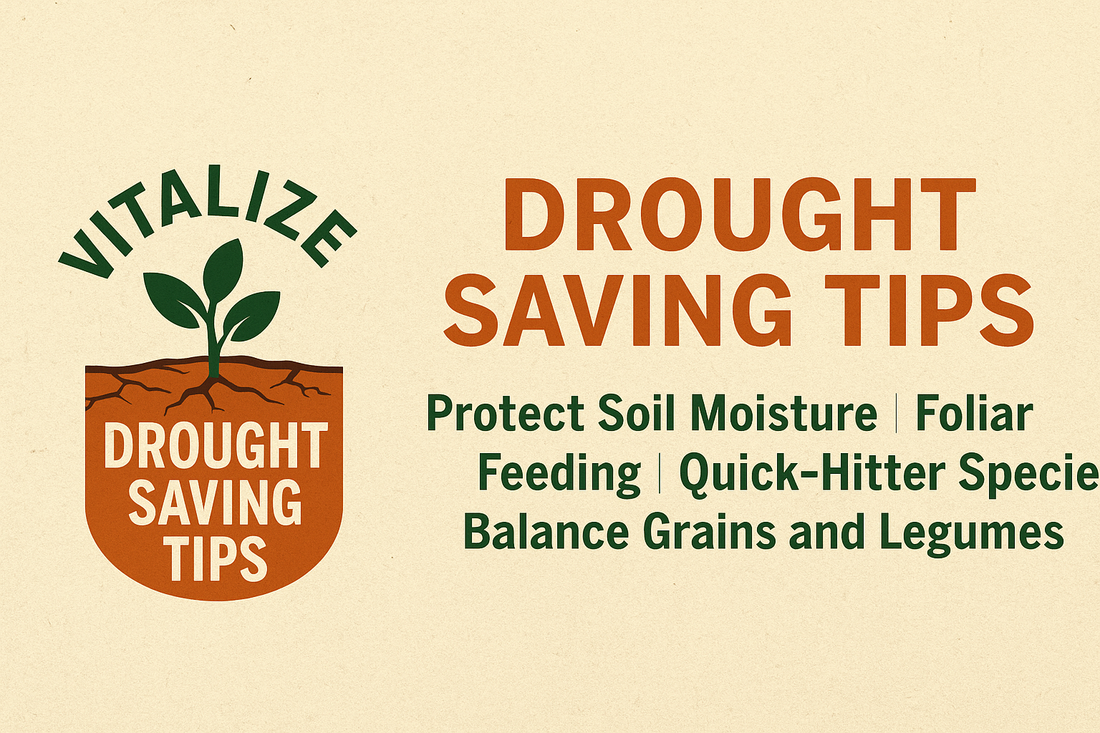
When to Save a Plot Due to Drought
Share
Drought can break a season in a hurry. You watch seedlings emerge, only to see them stall or fade under relentless heat and dry conditions. It leaves many growers asking: Should I scrap this plot and start over, or can I save it?
At Vitalize Seed, we believe there is often more resilience in your soil and your mix than you might think. We also believe in sound soil health practices, the same ones we preach every day. But despite all that, severe drought can still hurt yields. Especially in no-till systems, saving a drought-stressed plot can be both practical and productive when approached the right way.
When to Save a Plot
Partial survival (30–50% stand): Overseeding with complementary species can fill gaps without tillage.
Established but stressed seedlings: This is where no-till shines. Protect the soil, keep what you have, and focus on rescue strategies.
How to Save a Drought-Stressed Plot
No-till growers have an advantage here. By leaving residue on the surface and minimizing disturbance, moisture is preserved, microbial life is protected, and stressed plants can recover more quickly. To give the plot a boost:
Foliar rescue: Apply a light foliar feeding (Revive RX™, Bio-Charge™, REGEN-N+™) to deliver nutrients directly to the plant when roots are stressed.
Overseed with quick hitters: Drop in oats, peas, annual clovers, rye, or winter wheat. These species establish quickly, thrive on limited moisture, and maintain healthy soil biology.
Relieve pressure: Exclusion fences are a great way to measure browsing pressure and understand how much impact deer are having on your plots. If pressure is too high, this is where good management makes the difference. The solution is often to harvest more deer, create more food, or both. This will more so help the field the next season.
My Stance on Rye
I have been very outspoken that I am not a fan of overusing cereal rye. At the same time, I will say openly that rye is one of my favorite species. It is cold-hardy, dependable, and an incredible soil-builder. But when it is overdone, it can:
- Tie up nutrients in the spring
- Slow down nutrient cycling
- Frustrate growers when crops look yellow or stunted, leading many to give up on no-till altogether and till the plot just to reduce thatch cover. This is often the issue the next year.
The problem is even worse if rye is seeded too heavily and not terminated until May. By that point, rye is relatively mature, the residue is very high in carbon, and nutrient tie-up becomes almost inevitable. This is why, even in row crop systems where rye is the backbone of the cover crop program, you will almost always see annual clovers or other legumes blended in to offset nitrogen tie-up and to ensure the seeding rates are appropriate. The same principle applies in food plots.
For that reason, I only recommend using rye in this way as a rescue mission. If you are planting under normal conditions and simply want to increase plant density, I would much rather see you plant Carbon Load at a slightly higher rate per acre. That keeps the ratios accurate, the diversity balanced, and avoids creating an over-dominant stand of rye.
That said, rye can still be a valuable tool when used thoughtfully. I generally recommend filling gaps with 25–75 lbs per acre of a rye and oat blend. The blend should be balanced so that oats make up about one-half to one-third of that total rate. For example, if you seed 50 lbs per acre of grains, that could be split as 25 lbs of rye and 25 lbs of oats.
Ideally, then pairing rye and oats with:
-
6 lbs per acre annual clover (for nitrogen fixation and residue balance)
This approach ensures you are not overloading a stressed system, especially if you are overseeding into something like Carbon Load. It keeps rye in check, reduces the risk of C:N tie-up, and works especially well in no-till systems where residue decomposes more evenly on the surface.
Managing C:N Ratio for Next Spring
The goal is to rescue the plot without creating new problems. That is why balancing rye with oats and clovers is so effective:
- Rye: Provides insurance and ground cover
- Oats: Winterkill and reduce spring residue
- Annual clovers: Add nitrogen and speed up decomposition
No-till bonus: Residue stays at the surface where biology can break it down naturally.
Why It Works
- No-till systems maximize every drop of moisture and every bit of biology. Disturbance only compounds stress during drought.
- Balanced grain and clover mixes keep soil covered, feed biology, and reduce spring nutrient tie-up.
- Foliar feeding gives plants an immediate lifeline when root uptake is limited.
- Good management of browsing pressure ensures your efforts are not wasted.
The end result is a plot that not only survives drought pressure, but also sets you up for stronger spring planting without major fertility drag.
Practical Takeaway
Do not be too quick to tear up a drought-stricken plot. In most no-till systems, rescue is possible and often preferable. With the right balance of rye, oats, winter wheat, and annual clovers, timely foliar support, and active deer management, you can protect your soil, feed wildlife, and reduce input costs.
At Vitalize Seed, we are committed to providing you with the tools and knowledge to make informed decisions with confidence. Soil-first, biology-driven, and always practical.
Don’t take our word for it; here is the science:
| Topic | Supporting Research | Link |
|---|---|---|
| Rye maturity increases C:N ratio and tie-up | USDA NRCS Cover Crop Termination & Rye Fact Sheets | NRCS Rye Fact Sheet |
| Late termination doubles biomass, increases residue load | University of Delaware Agronomy | Cover Crop Biomass & Termination |
| Ideal residue C:N ratio ~24:1, higher ratios immobilize N | Ohio State Extension | OSU C:N Ratio Factsheet |
| No-till improves drought resilience and soil health | Blanco-Canqui & Ruis review (Soil Science Society of America) | Soil Health & No-Till |
| No-till roots improve water capture in surface soil | Meta-analysis, Canadian Journal of Soil Science | No-Till Root Study |
| Foliar feeding provides nutrients when roots are stressed | University of Missouri Extension | Foliar Feeding Extension |
